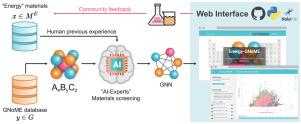energy - gnome:能源应用中选定材料的活数据库
IF 9.6
Q1 COMPUTER SCIENCE, ARTIFICIAL INTELLIGENCE
引用次数: 0
摘要
材料科学中的人工智能(AI)正在推动能源应用先进材料的发现取得重大进展。最近的GNoME协议确定了超过38万个新的稳定晶体。由此,我们确定了超过38,500种有潜力成为能源材料的材料,形成了energy - gnome数据库的核心。我们独特的机器学习(ML)和深度学习(DL)工具组合使用特征空间减轻了跨域数据偏差,从而确定了热电材料、新型电池阴极和新型钙钛矿的潜在候选材料。首先,具有结构和组成特征的分类器检测适用性领域,我们期望在这些领域增强回归器的可靠性。在这里,回归量被训练来预测关键的材料性能,如热电性能图(zT)、带隙(Eg)和阴极电压(ΔVc)。这种方法大大缩小了潜在候选材料的范围,为实验和计算化学研究提供了有效的指导,并加速了适合发电、储能和转换的材料的发现。本文章由计算机程序翻译,如有差异,请以英文原文为准。

Energy-GNoME: A living database of selected materials for energy applications
Artificial Intelligence (AI) in materials science is driving significant advancements in the discovery of advanced materials for energy applications. The recent GNoME protocol identifies over 380,000 novel stable crystals. From this, we identify over 38,500 materials with potential as energy materials forming the core of the Energy-GNoME database. Our unique combination of Machine Learning (ML) and Deep Learning (DL) tools mitigates cross-domain data bias using feature spaces, thus identifying potential candidates for thermoelectric materials, novel battery cathodes, and novel perovskites. First, classifiers with both structural and compositional features detect domains of applicability, where we expect enhanced reliability of regressors. Here, regressors are trained to predict key materials properties, like thermoelectric figure of merit (), band gap (), and cathode voltage (). This method significantly narrows the pool of potential candidates, serving as an efficient guide for experimental and computational chemistry investigations and accelerating the discovery of materials suited for electricity generation, energy storage and conversion.
求助全文
通过发布文献求助,成功后即可免费获取论文全文。
去求助
来源期刊

Energy and AI
Engineering-Engineering (miscellaneous)
CiteScore
16.50
自引率
0.00%
发文量
64
审稿时长
56 days
 求助内容:
求助内容: 应助结果提醒方式:
应助结果提醒方式:


